Gradius was successful enough for Konami to follow up with another space shooter. Salamander is for the most part a very different game. You power up your ship by straight up collecting various power up items, every even stage scrolls vertically and your ship respawns upon death. No more checkpoints. Unfortunately that makes recovery no more possible than it was in Gradius, actually, I think it's worse in this one. Almost every stage past the first one is impossible to tackle without improved fire power and speed. Powering up was also easier in the first game, especially since speed ups were almost always available right after every check point. In Salamander there's about one speed up item per stage. But for all of its divergences from the mechanics of Gradius, you still control the Vip Viper as player 1, you still get the iconic options following your ship and the laser and force field are oddly similar to their equivalents from Gradius. That is if you ignore that this game's force field is actually completely useless. It absorbs less hits than it did in Gradius and its huge hitbox almost guarantees that it's going to disappear before it could ever be of use. Personally I've put more hours into this game than is reasonable and have never experienced the force field tanking a bullet that would have otherwise killed me. Further similarities with Gradius are reused enemies, hazards and terrains. The game also saw a couple of revisions and was later rereleased with Gradius' famous power up system, but more on that later.
Salamander
Salamander is the original japanese release of this title. Much like Gradius this one also has a plethora of technical issues, but this time they are harder to work around. This game isn't even frustrating, it's a complete meme. It's broken.
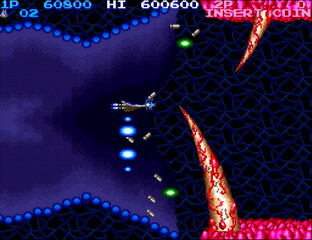
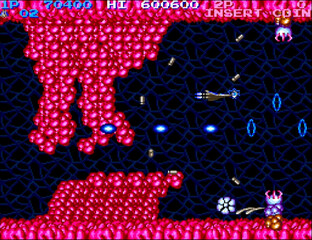
Stage 1 plays straightforward and harmless, it's even a bit boring because there is too much dead air, until you reach the regenerating wall right before the boss that is much harder to deal with than is reasonable for an obstacle in a games' first stage. And you have to learn to deal with it because going without power ups into stage 2 results in a death sentence.
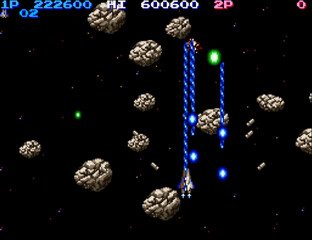
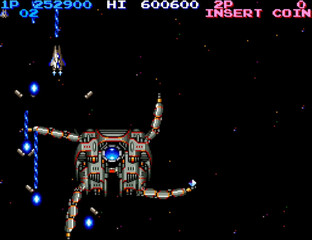
The asteroid assault in stage 2 appears worse than it is, if you've got all your power ups from stage 1. I have never made it far into this stage without them however. That aside this stage plays surprisingly fine, it's probably the best designed stage in the game. Funnily there's an enemy here that doesn't attack your ship directly, but instead causes the screen to flash white. Must have been really distracting on original arcade monitors running at high contrast. Hopefully nobody with a tendency to suffer from seizures played this back in the day.
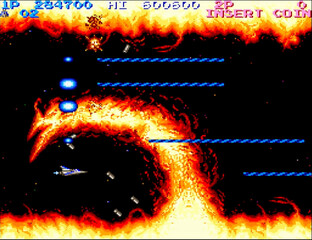
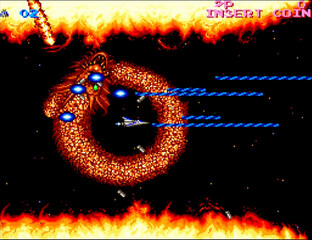
Stage 3 was a comfortable breather after painfully working my way through Gradius before. It only requires a bit of hazard memorization that is easy to get down with a save state. The developers probably wanted players to enjoy the (for their time) amazing visuals of this stage. Although it's almost silly easy to clear once you get the knack for it and has an insane amount of dead air, this is still one of the less offending stages Salamander has to offer.
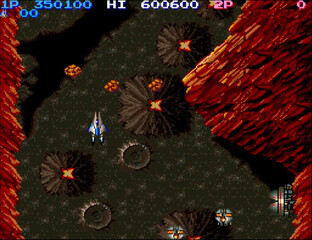
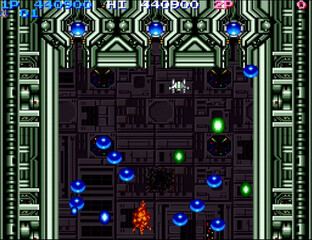
Because the real fun begins in stage 4. The slowdown here often causes your ship's hit box to desync from its sprite, making some of the tighter sections almost impossible to survive. Enemies rise above from the ground in ways that can be hard to predict, and if your hit box is desynced they'll still kill you even if you manage to dodge them. The more I practiced this stage the less consistent I got at it, it's more frustrating than anything I had to go through in Gradius. It's just baffling that this design got green-lit for release. Then there's this stage's boss that's usually impossible to kill. It spawns an absurd number of bouncy balls into a tight area with little room for you to dodge. Your best shot is to hide in a near-pixel-perfect save spot in one of the bottom corners (have fun getting this consistent). Alternatively, the boss becomes easier on further credits when it somehow spawns less (or no, or so I've heard) bouncy balls than on a first credit. The term quarter muncher has never been this appropriate.
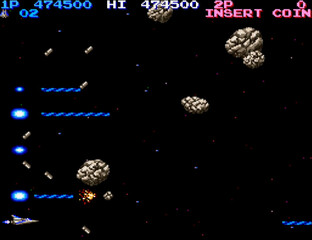
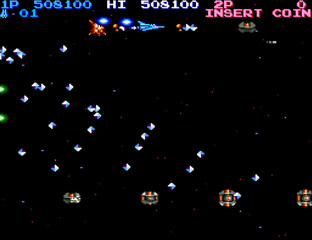
Now if this hasn't been enough to stop you from playing this one, stage 5 features a few enemy patterns that are impossible to survive unless you know exactly how to deal with them. This is where you start wondering where your extends are. Because unlike Gradius that showered you with extra lives, Salamander offers you not even one of them. I don't want to imagine what practicing this game must have been like in the arcades without save states.
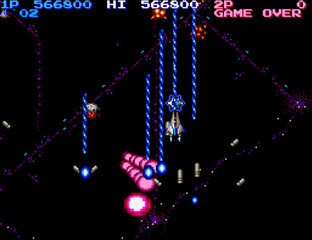
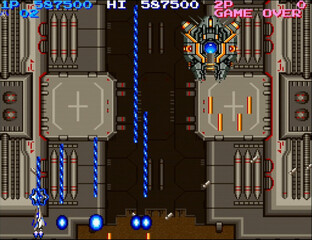
At least the final stage plays much better than the previous two, but is designed to burn the memory of Salamander's terrible hit boxes into your mind. I found the finale of Gradius to be a lot more fun to play than this clunky mess. The Moai enemies near the end of the stage also feel completely out of place. Stage 6 feels like a mix of a bunch of stages the developers intended to implement but lacked the time to do so.
Life Force
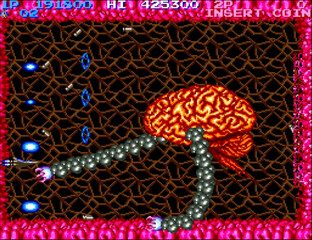
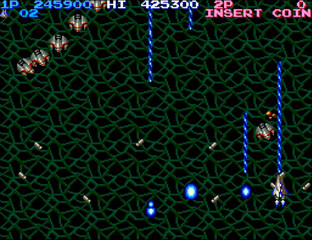
It seems that Salamander's first stage was what made the game popular in Japan and Europe, because the later US release came with quite a few changes to the original's setting: space backgrounds were replaced with recolors of the stage 1 background and the announcer now shouts narrative comments such as "Destroy violent antibiotics!", "Entering liver area!", "Destroy bio-mechanical brain attachment!". They're so stupid it's hilarious. And absolutely unfitting since stage 4 still has its volcanoes and the mechanical boss area. Instead of fixing Salamander's game-breaking issues they chose to turn the game into a complete joke. Really, the only gameplay change I could make out is that one of the living walls in stage 1 now spreads further.
Life Force .... again?!
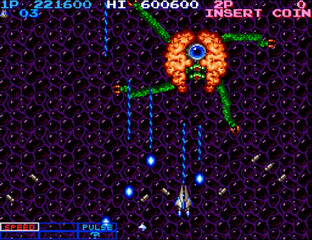
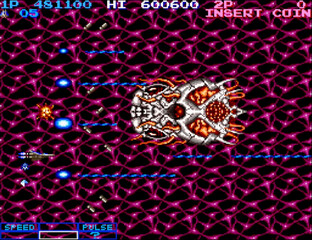
But the developers weren't satisfied with what they had done to Salamander with their first revision of Life Force. They went out of their way to modify the presentation of Life Force even further with another release for the japanese market. This one replaces most mechanical enemies with organic fiends, does further changes to backgrounds (although the volcanoes in stage 4 are still intact...), completely changes the sprites of most bosses and surprisingly fixes a few of Salamander's gameplay problems. Accumulating score now yields extends, many previously non-hostile enemies now also fire at you, the previous power up system was replaced with Gradius' token system with its iconic power up bar and the boss at the end of stage 4 now always shoots a fixed number of bouncy balls that is just about manageable. Supposedly power up items in previous releases dealt damage to the force field which should be fixed now, and the force field can now be powered up further to also protect the sides of your ship. However stage 1 is still really boring to play with all of its dead air. Getting through its regenerating walls is still a dice roll and the player ship hit box is still way too large for the game's tighter sections. I still die in stage 4 without knowing what even hit me. They could have improved so much more here instead of double dipping on the organic aesthetics that I personally appreciate much less than the space theme of the original (although I really like the new sprite for the stage 5 boss).
I suppose at least the visuals and sound are in some ways improvements over what Gradius offered. Backgrounds are more diverse even in the original release of Salamander and the soundtrack is well composed from start to finish, no more silly beep-boop background music like Gradius had on some of its stages. The japanese revision of Life Force even comes with new and improved music for many stages. However the music and setting of this game don't appeal to my tastes very much. I could have forgiven japanese Life Force for its aesthetics had it done more to improve on the gameplay, but since that didn't happen working on the 1cc is also not worth my time in the game's latest revision. In short, this one's just not my cup of tea, but I can see that it has a lot of elements that are impressive for its time.
